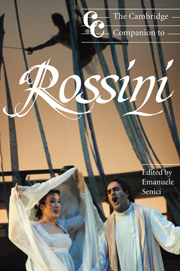3 - Rossini and France
from Part I - Biography and reception
Published online by Cambridge University Press: 28 September 2011
Summary
The nationality of Rossini
For those who wander Père-Lachaise cemetery in Paris in search of celebrity graves, the tomb of Rossini is mercifully easy to find. By contrast with the narrow, winding paths to Chopin's memorial, or the detour through undergrowth necessary to pay homage to Bellini, Rossini's dwelling, in death as in life, sits squarely on a main boulevard. His name carved in capitals on the lintel, the grave follows the Second Empire entrance porch design, rejecting the faded, overgrown decrepitude of the simple stele for the solidity of a miniaturised Haussmannian apartment block. Rossini, however, is no longer there. The grave is an empty memorial, robbed of the invisible remains that give such visits their existential satisfaction.
Any literal suggestion of robbery is, of course, unfounded. On a cold, rainy day in the late spring of 1887 the Italian ambassador to France, the head of the Paris Conservatoire, and other notables from the two countries gathered for an official ceremony. Rossini's body was disinterred, his coffin opened to confirm his identity, and music and speeches provided to mark the transfer of the composer from French to Italian authorities. He was then taken by train to Florence, where a series of more elaborate celebrations took place to welcome his corpse to its final location in the church of Santa Croce. Yet the speech given in Père-Lachaise by the Prefect of the Seine, Eugène Poubelle, while not explicitly mentioning theft, conveyed a marked lack of conviction about the return of Rossini to the country of his birth.
- Type
- Chapter
- Information
- The Cambridge Companion to Rossini , pp. 25 - 36Publisher: Cambridge University PressPrint publication year: 2004
- 2
- Cited by

